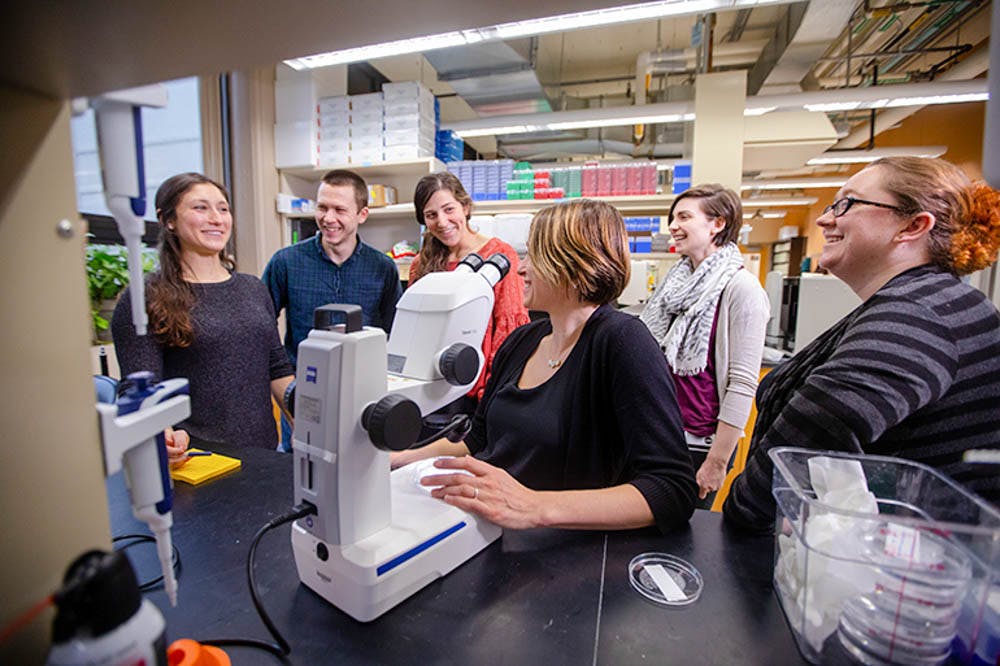Since 2016, the Plavicki lab has explored the ways that environmental contaminants, which are chemical stressors, affect the brain and heart development of zebrafish.
Along with a team of three undergraduate students, three graduate students, two postdoctoral fellows and a research assistant, Assistant Professor of Pathology and Laboratory Medicine Jessica Plavicki watches zebrafish develop in real time.
The Plavicki lab has fostered a large zebrafish population to advance their research efforts. Zebrafish are a useful model organism because they are initially transparent, and can be kept transparent by applying chemical inhibitors to pigmentation. The lab uses zebrafish that are transgenic, which means that researchers altered the fish’s genetic code to express desired physical characteristics: for example, editing genes so that a color is visible within a zebrafish’s heart. “We can see glowing blood through glowing vessels. We can watch those vessels as they form, as they dive into the brain. We can watch the heart beat. We can watch the pancreas as it takes shape,” Plavicki said.
Transgenic fish help the lab understand how other physiological systems work as well, including the muscles and digestive tract — in the lab’s case, specifically how the fish are affected by environmental contaminants. “We can also look deeper at what molecular or genetic pathways are dysregulated following these exposures,” said Nathan Martin GS, a fourth year pathobiology graduate student who has been working in Plavicki’s lab since 2016.
The lab aims to understand the DNA regulatory transcription factor sox9b. Transcription factors are DNA components that mediate what genes are turned on or off in an organism. The lab investigates sox9b’s role in the development of great vessels, which bring blood to and from the heart as well as cardiomyocytes, which are heart muscle cells.
Sox9b is a transcription factor expressed in many different cell types during development, but different environmental contaminants can reduce the frequency of its activation. Sox9b is the zebrafish equivalent of sox9, a human gene. People with congenital heart disease have mutations in sox9, but few researchers have conducted significant research on the mutation’s effects.
“If we see that sox9b has a role, it gives us more information about where this disease originates,” said Layra Cintron-Rivera GS, who works on the project which is funded by a Center of Biomedical Research Excellence grant from the National Institute of General Medicine Phase II. Research on sox9b in zebrafish could therefore have promising implications in human therapies for congenital heart disease, given the similarities between sox9b and sox9, she added.
Zebrafish are an especially good model for studying congenital heart disease. The same disease in mammals would cause them to die due to a lack of circulating oxygen, but zebrafish do not have this problem. “Fish, because they are developing in water, can get oxygen from passive oxygen diffusion. They can have a lot of severe vascular malformations and still survive, so that allows us to identify new genes or identify different functions for genes that you wouldn’t be able to explore in other systems,” Plavicki said.
The National Institute for Environmental Health Sciences funds a project in the lab about the impact of environmental contaminants on the brain. The researchers are studying how such environmental contaminants affect the early development, differentiation and function of neurons, Martin said. He works specifically with AHR, a transcription factor that interacts with different environmental contaminants when activated. These interactions then repress sox9b’s function, which can cause neurovascular and neural developmental disruptions.
The lab is also conducting a pilot project on one environmental contaminant, called PFAS, which can affect neural development and brain’s response to injury. This project is supported by the Brown Superfund Research Project Center.
Beyond her research projects, Plavicki wants “to help (her) students succeed in their goals, progressing through their PhD programs and helping them submit applications for various individual funding mechanisms.” She also teaches a course called BIOL1820: “Environmental Health and Disease” that she plans to “continue to develop and make it the best teaching mechanism it can be.”
Plavicki believes that “a lot of the times people don’t consider their environment as a significant influencer of their overall health and wellbeing, but we need to think about health and disease more comprehensively.”





